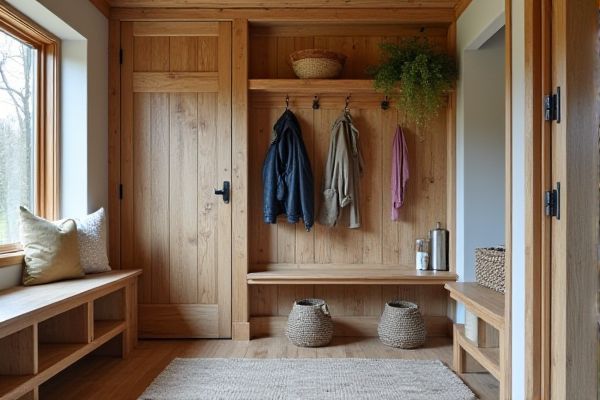
Mudroom barnwood offers rustic charm and durability with its naturally weathered texture, while reclaimed wood boasts a unique history and eco-friendly appeal due to its recycled origin. Explore the rest of the article to discover which material best suits your mudroom design and personal style.
Table of Comparison
| Feature | Mudroom Barnwood | Reclaimed Wood |
|---|---|---|
| Source | Old barns, outdoor structures | Various salvaged wood from buildings, factories |
| Appearance | Rustic, weathered with barn character | Varied patina, textures, and wood types |
| Durability | Strong, aged wood with natural resistance | Depends on previous use, often sturdy |
| Environmental Impact | Eco-friendly, reuses barn materials | Highly sustainable, reduces waste |
| Cost | Moderate to high due to sourcing | Varies, often cost-effective |
| Common Uses | Mudrooms, accent walls, furniture | Flooring, furniture, cabinetry |
| Maintenance | Requires sealing to prevent damage | Needs occasional refinishing |
Introduction to Mudroom Design Materials
Mudroom barnwood offers rustic charm with its rough, textured surface often sourced from barns and aged structures, providing durability and a weathered aesthetic ideal for high-traffic entryways. Reclaimed wood, on the other hand, includes a wider variety of sources such as old buildings and pallets, offering diverse grain patterns and environmental benefits by recycling materials. Choosing between mudroom barnwood and reclaimed wood depends on your design preference and the level of authenticity you want to bring into your home's functional transition space.
What is Barnwood?
Barnwood refers to aged, weathered timber salvaged from old barns, characterized by its rustic texture, natural patina, and historical authenticity. This type of wood is valued for its durability, unique grain patterns, and eco-friendly reuse, making it ideal for mudroom designs that emphasize a vintage, farmhouse aesthetic. Unlike reclaimed wood, which may come from various sources including factories or warehouses, barnwood specifically originates from dismantled barns, lending a distinctive charm and story to each plank.
Understanding Reclaimed Wood
Reclaimed wood in mudroom designs offers unique character by repurposing aged materials from old barns, factories, or warehouses, providing sustainability and rich texture. Unlike standard barnwood, reclaimed wood often undergoes thorough cleaning and milling to remove nails, dirt, or contaminants while preserving natural patina and imperfections. This process ensures durability and enhances aesthetic appeal, making reclaimed wood a versatile choice for eco-friendly, rustic interiors.
Key Differences: Barnwood vs Reclaimed Wood
Barnwood typically refers to aged wood harvested from old barns, known for its weathered texture and rustic character, while reclaimed wood includes any salvaged wood repurposed from various sources such as factories, warehouses, or homes. The key differences lie in origin and appearance: barnwood offers a distinct, nostalgic aesthetic with knots and nail holes that enhance mudroom charm, whereas reclaimed wood provides diverse grain patterns and finishes, reflecting its varied past uses. Choosing between barnwood and reclaimed wood for your mudroom depends on the desired style, durability, and historical appeal you want to achieve.
Aesthetic Appeal in Mudroom Applications
Mudroom barnwood offers a rustic and weathered aesthetic characterized by natural imperfections and varying textures, creating a cozy, farmhouse-inspired ambiance. Reclaimed wood, sourced from diverse origins like old barns and factories, presents a unique blend of historical character and patina, with more varied grain patterns and tones ideal for eclectic or vintage decor. Both materials enhance mudroom designs with authentic charm, but barnwood emphasizes a consistent rustic look while reclaimed wood provides greater visual diversity and storytelling potential.
Durability and Maintenance Considerations
Mudroom barnwood offers superior durability due to its dense grain and natural resistance to wear, making it ideal for high-traffic areas prone to dirt and moisture. Reclaimed wood, while eco-friendly and rich in character, may require more maintenance such as sealing and periodic refinishing to address potential imperfections and exposure to previous elements. Proper treatment of both materials enhances longevity, but barnwood generally demands less upkeep due to its sturdier condition.
Environmental Impact and Sustainability
Mudroom barnwood offers a sustainable choice by repurposing aged wood, reducing the need for new lumber and minimizing deforestation. Reclaimed wood, sourced from old buildings or structures, further lowers environmental impact by diverting waste from landfills and preserving natural resources. Choosing your mudroom materials wisely supports eco-friendly practices and promotes sustainability in home design.
Cost Comparison: Barnwood vs Reclaimed Wood
Barnwood typically costs less than reclaimed wood due to its easier availability from old barns or structures, offering an affordable yet stylish option for your mudroom. Reclaimed wood, sourced from various old buildings or industrial sites, carries a higher price tag because of its unique character and the labor-intensive process of harvesting and preparing the material. Choosing between barnwood and reclaimed wood depends on your budget and desired aesthetic, with barnwood providing a cost-effective solution and reclaimed wood delivering distinctive charm at a premium price.
Installation Tips for Mudroom Projects
When choosing between mudroom barnwood and reclaimed wood for your project, ensure you properly prepare the surfaces by sanding and sealing to prevent splinters and moisture damage. Measure accurately and use a level during installation to maintain alignment, while securing boards with corrosion-resistant screws for durability. Your mudroom will benefit from pre-drilling holes to avoid wood splitting and applying a protective finish suited for high-traffic areas.
Choosing the Best Wood for Your Mudroom
When selecting wood for your mudroom, barnwood offers authentic rustic charm with its weathered texture and unique character, making it ideal for a cozy, farmhouse aesthetic. Reclaimed wood provides an eco-friendly option, often boasting greater durability and a diverse range of finishes due to its previous use in different structures. Your choice depends on the desired visual appeal and the importance of sustainability and durability in your mudroom design.
 homyna.com
homyna.com